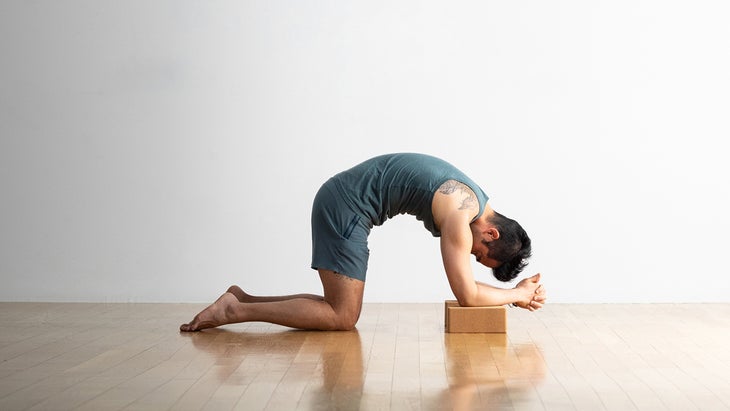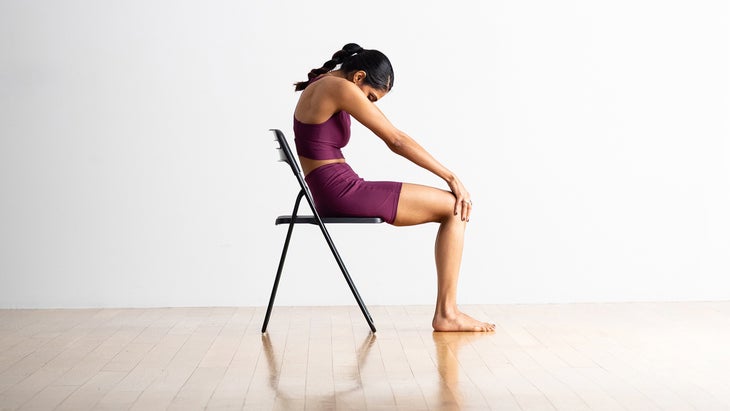Cat Pose
How to avoid falling into autopilot while practicing this basic—but beneficial—stretch.
Heading out the door? Read this article on the new Outside+ app available now on iOS devices for members! Download the app.
You rarely encounter Cat Pose, or Marjaryasana, in yoga class without also being cued into Cow Pose, Bitilasana. Together, these poses engage your core and release tension in your back as a way to prepare you for what’s to come. Although it’s such a common pose that it can be easy to rush through it mindlessly. Slow down. Let yourself experience it. Sync your breath to your movement. Take a moment to find stillness in your body. Permission granted to ignore the teachers’ cue and linger here as you feel your hands press into the mat and your neck release. That awareness can set the stage for the rest of your practice.
Sanskrit
Marjaryasana (Mar-jar-YA-SUN-ah)
Marjari = cat
asana = pose
How to do Cat Pose
- Begin in Tabletop with your hips directly over your knees. Your hands should be shoulder-distance apart and slightly ahead of your shoulders.
- Bring your wrist creases parallel to the front of the mat. Spread your fingers wide and press down firmly through your knuckles.
- Exhale and round your spine toward the ceiling as you release your head and your tailbone toward the mat. Relax your neck. There’s no need to tuck your chin.
- Push the floor away with your hands to help broaden across your shoulder blades. Draw your navel toward your spine.
- Keep the hips over your knees and your arms straight to isolate the movement to your spine.
- To release the pose, return to a neutral spine in Tabletop.
Cat Pose Variations

Cat Pose With Blocks
If you have pain in your wrists or hands, bring your forearms to blocks. If you don’t have blocks, try firm pillows or a small stacks of books.

Cat Pose in a Chair
Sit on a chair with your feet under your knees, hip-distance apart. (If you are taller, you may need to sit on folded blankets. If you are shorter, you may need to put folded blankets or blocks under your feet, so that your knees are at a 90-degree angle.) Inhale and sit as tall as you can. Exhale and round your spine while releasing your chin toward your chest.
Cat Pose Basics
Pose Type: Backbend
Targets: Core
Benefits: Cat Pose stretches your wrists, shoulders, and spine and prepares you for further movement. The slow rhythm you create when you move between Cat Pose and Cow Pose helps you sync your breath and body. It can also help you calm down by inciting the relaxation response (parasympathetic nervous system). When practiced with mindfulness, the pose also enhances body awareness. Cat Pose warms up your spine, shoulders, and hips. It improves body awareness and posture, and counteracts the effects of sitting. Strengthens and stretches your back muscles, abdominals, shoulders, wrists, and hips.
Beginner Tips
- Relax your neck rather than holding it tense so your head releases toward the mat.
- Keep your shoulders away from your ears.
Common Misalignments
- Keep your arms straight rather than allowing them to bend and splay out to the sides. This isolates the stretch in your spine.
- There’s no need to force your chin toward your chest.
Why We Love Cat Pose
“This pose is one of my absolute favorites because it sets the stage for many of the postures we encounter later on in a practice,” says YJ contributor Jenny Clise. “In its simplest form, it flexes our spine, stretches our back, and strengthens our core. Cat Pose also offers an often overlooked tool: shoulder protraction. When stepping to the top of our mat from Table or Downward-Facing Dog, we must protract our shoulders—draw the shoulder blades away from one another to broaden across your back—and make room for our foot to step through. When approaching arm balances like Crow or Crane Pose or Handstand, it is not just our core that is working. Our shoulders need to be protracting like crazy! Whenever I face a roadblock in my practice, I think about what postures exist within the one I am trying to achieve—and then I return there. I cannot tell you how many times I have returned to Cat Pose.”
How to Teach Cat Pose
- Remind students that they can slide a folded blanket beneath their knees for cushioning.
- Suggest shifting the body in different directions, whether side to side (stretches the obliques) or forward and back (stretches the wrists and forearms).
Preparatory and Counter Poses
Cat Pose can be used as a counterpose to backbends but be careful to only take your body into it after you first stay for several breaths in a neutral spine position, such as Child’s Pose.
Preparatory Poses
Tabletop
Counter Poses
Uttana Shisosana (Extended Puppy Pose)
Section dividerCat Pose in Practice
- 7 Poses to Melt Away Neck and Shoulder Pain
- 8 Yoga Poses to Ease Lower Back Pain
- Short on Time? This 15-Minute Yoga Flow Is Perfect for Those Impossibly Busy Days
About Our Contributors
Teacher and model Natasha Rizopoulos is a senior teacher at Down Under Yoga in Boston, where she offers classes and leads 200- and 300-hour teacher trainings. A dedicated Ashtanga practitioner for many years, she became equally as captivated by the precision of the Iyengar system. These two traditions inform her teaching and her dynamic, anatomy-based vinyasa system Align Your Flow. For more information, visit natasharizopoulos.com.